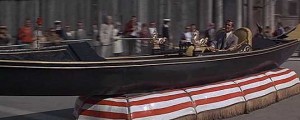Re-re-re-designing a Mission, Part 1
As I teased at the bottom of the last post, I’ve been redesigning and reimplementing what I call “the bookshelf mission”. My good friend and Spore art director Ocean Quigley tells me I shouldn’t call it “the bookshelf mission” because that doesn’t sound very cool and spy-like. If that bothers you, you can call it “the mission where you pick up the hidden microfiche1 and take it to another dead drop by various forms of subterfuge”. One great thing about working on spy games is that you can basically take any situation, regardless of how absurd, and wrap a spy fiction around it. I mean…


Truth be told, I’m just not worrying about the fiction right now; I’m completely focused on the core gameplay, and making it as deep and interesting as I possibly can, and I’m 100% confident that no matter where the design leads me, the results won’t be as absurd as Moonraker.
The old bookshelf mission mission was one of the more interesting missions in the SpyParty gameplay prototype, for a number of reasons. First, let me describe the mission, hopefully for the last time, since I just gutted it. :)
Here’s the current test level, called the ballroom:

Yes, it’s a box, with windows on two sides. In addition to ignoring the fiction, I’m also not worrying about level layouts very much yet! Every playtest you’ve read about in the press has been in this box. I’ve got the geometry for a couple more levels built, but haven’t needed to trot them out yet to keep things interesting, so they’re on the back burner for now.
Back to the bookshelves. You can see there are two of them in this level, one blue and one green. You can see some NPCs at the bookshelves, reading. I’m the woman in the plaid dress with the green triangle over her head. Don’t shoot me, I’m trying to explain something.
The NPC AI will occasionally decide to go to the bookshelves, take a book out, page through it for a bit, and then put it away, and go do something else. As the Spy, you can of course do the same thing.
The old bookshelf mission went like this:
- Your goal is to move a book from one of the bookshelves to the other. You can choose while playing whether you move it from the blue to the green, or vice versa, and that’s part of the strategy, since they have different levels of occlusion due to location and nearby people traffic.
- For this example, let’s say you start at the blue bookshelf.
- You can pick up a book like the AIs, and you’ll sit there and read it.
- While you’re reading it, you have two affordances2, you can Put the book away like the AI, or you can Pretend to put the book away, but actually hide it in your jacket.
- If you put the book away, you look exactly like the AI when they put it away.
- But, if you hide the book, the animation is a little different. This is a hard tell, which I’ll talk about at length in another post, but it basically means it’s something the AI will never do, so if the sniper sees this clearly, you’re made.
- Once you’ve got the book hidden, you can go over to the green bookshelf. It’s not usually a good idea to beeline right from one bookshelf to another, because the NPCs rarely do that, so go talk to some people first, or look at some artwork.
- This is where things got a little overly complex. At the green bookshelf, you can either Pick up another book, in which case you have a hidden book from the blue bookcase and a book from the green bookcase in your hands, or you can Fake pick up a book but really take the hidden book out, in which case you’ll have a book from blue in your hands and nothing hidden.
- If you’re holding a book, then you have the option to put the book away.
- But, if you picked up a green book, you could then Swap the held and hidden books, so you’d have the book from blue in your hands, and a hidden book from green.
- Once the book from the blue bookcase is in your hands, whether it got there from a fake pickup and unhide, or swapping, if you put it away normally you’d accomplish the mission.
If you think that’s complicated to understand reading it here, you should have tried playing it. As I’ve said before, I’m wholeheartedly invested in the Blizzard Depth First, Accessibility Later development style, but man, you need people to be able to figure out how to put a damned book away while they’re playtesting your game. There is text displayed when an affordance is available, and one of them for this mission was “Fake Pick Up Book with Hidden and Hold It”. I can hardly parse that sitting here reading it, let alone when I’m worried somebody is going to shoot me in the head if I screw up.

It may have been a trainwreck from a learning standpoint, but the affordances were designed this way for a reason. The complexity was a direct result of the design goal that you always be able to “play it cool” if the sniper’s laser swept over you and he or she started paying attention to what you were doing at the bookcase. You always needed the option to do exactly what the NPCs would do at any moment (assuming you weren’t in the middle of playing a hide animation or whatever), and these affordances gave you that option, at the cost of clarity.
So, a redesign was in order, but…
Once people learned the state machine, it was actually a good mission with many interesting characteristics I wanted to preserve. For example, it was the only mission that took place across space in the level instead of at a point. It was two-part, with tells at either end, which made it hard for the Spy, but rewarding when you pulled it off. The Spy got to choose the order, so the Sniper was never sure which bookshelf to be watching for late in the match. It had a nice version of David Sirlin’s yomi layer concept, in that since it was hard, Snipers would assume Spies would not choose it. Of course, this made Spies choose it. It had fixed known locations where it would happen, so it could be camped, but while camping it, the Sniper was not looking elsewhere. Etc.
Yikes, it’s 4:23am. Okay, more on this redesign tomorrow…







These posts are very interesting, keep up the good work and stop stop making them (or the game). I’m really looking forward to playing this (especially with a friend and voice chat), but you should take all the time you need to make this game as awesome as possible.
PS: I have no idea what a microfiche is.
“Don’t shoot me, I’m trying to explain something.”
Made me laugh :)
Sopunds like a difficult mission for both sides, nice job!
I can imagine that long text buttons with “Pretend to pick up book but really unhide the hidden one” could test the brain while reading and trying to act AI.
Two work around I can think of are replacing buttons with a noticeable icon and have a slideshow tutorial before gameplay begins.
The second would be the button having a animation that clearly shows what goes on.
I haven’t play tested your game though and I don’t know what kind of interface style you’re going for, I’ve only seen rough screens.
Food for thought though, thought I’d throw in my two pence.
Keep up the good work.
I will post the solution I’ve come up with tomorrow. I’m going to playtest it on Thursday, so we’ll see if it’s better!
Sounds cool. That is a difficult usability barrier with the text while trying to maintain “invisibility”. Perhaps you could work the controls as a general rule of thumb method. EG: circle/B would be “Play it cool”, Triangle/Y would be “feign legitimate action”, Square/X would be “Quick obvious switch”.
Also, for playability sake I would make sure that level completion requirement (the ending moment) is not the exact moment a mission is completed, otherwise the spy would complete the last action recklessly, b/c the sniper wouldn’t have time to react to his quick actions. Instead end the mission with a leave the front door, or something of that nature.
Yep on both points. Currently the A button is the “Normal” action in any given context, and the X button is the “Spy” action. The AIs basically walk around pushing the A button, practically speaking.
And, for the ending, I used to end it on the last mission complete, but people would save the risky mission for last and then it’s a freebie, so now it’s like Jenga, where the tower has to stay up for 10 seconds after your move, here a countdown timer starts (on the Spy’s screen) and you have to play it cool for 10 seconds.
You should have the option to end the mission by turning to the Sniper and giving him the finger, just to rub it in.
I love seeing the different challenges you have to face in developing this game, keep it up!
Hah, I actually was thinking about how taunts would work in SpyParty, and I came up with a pretty cool idea I’ll write another post about!
Maybe have a haunt where you can point a finger downwards to someones head, meaning, it’s this one, shoot him ^^
You could have the affordances as a menu
do X no faking
-> but really do Y
-> but really do Z
or vice versa
do X
-> but fake doing Y
etc
Personally I think the former is easier since the top menu level is simply everything the npc could do and provides a nice structure to fill with slight of hand activities.
Awesome post!
For the record, I am 25 and knew what both microfiche and affordance meant.
Also 25, I knew what microfiche was from library/various office jobs that still had them around in the past few years. I don’t give much hope to anyone younger though.
Do you have to remain still when reading? (By you I mean the player or the AI). While I don’t see any benches in that room, they aren’t inconceivable, and by extension you could have any of the guests be able to pick up a book, go to a bench, then start reading.
Also, have you thought about having the sniper exist as a more broad assassin? I had the thought when I was pondering what you meant by other map layouts, and how it’d be difficult for a sniper to cover an area that isn’t a totally convex shape- what if, in some cases, the sniper was also one of the guests in the room, but with the same task: identify and eliminate the spy. Admittedly some of the asymmetry is lost, but it’d allow for much more intricate levels (within reason, of course)
> Do you have to remain still when reading?
That’s one of the changes I’m going to write about next!
> Also, have you thought about having the sniper exist as a more broad assassin?
Yeah, there are a bunch of modes in the notebook (and the comments on these blog posts :) about that kind of thing, but even with the current purely asymmetric mode, I’m going to try some levels where the Sniper can’t see the whole map at the same time and see how that plays. There are enough tuning knobs that I don’t think it would necessarily be too advantageous for the Spy, since you could easily require some spacially bound missions to give the Sniper something to grab onto. Once I get more missions in and I’m sure the behavioral depth is where I want it, I’ll resurrect those other maps and start testing those angles.
I’m 21 and I quoted a microfiche in one of my Masters essays. I can’t be sure, but I’m fairly confident that’s what got me an A!
Hmm, I was having second thoughts about using the term “microfiche” instead of “microfilm”, but now maybe I should stick to my retro guns…
I was just thinking, is the amount of people in the room always constant? Could be a good difficulty modifier; less people in the room makes it more difficult to remain undetected.
That’s actually a really cool idea.
Yeah, currently each level specifies how many people are there. I use that for testing difficulty, like “12 people with 3 out of 4 missions” is about the same difficulty as “16 people with 4 out of 4”, but they feel different to play (if the Sniper knows all the missions have to be accomplished, then he or she can camp one of them, so more people makes it easier to be obscured by somebody). I’m eventually going to have people enter and leave the party, too.
1) 26 and yes, but only because my parents are into family research… never heard of it in the context of spy-fiction. I would go with microfilm. More iconic.
2) I’ve mostly heard this term only from Looking Glass alumni… \verbs\ seems more common.
I think there’s a subtle distinction between “verbs” and “affordances”, but yeah, they’re closely related. I think of verbs as actual actions, while affordances are knobs someone can interact with. A gun on the floor isn’t really a verb, but it is an affordance. You can always tell the affordances in an old Scooby Doo cartoon because they’re draw on the cell instead of into the background painting. :)
I love those little technical blog posts, and am deeply looking forward to this game. Keep it up!
If the spy chooses to start at blue, can he goto green, pocket a book, goto blue, take the microfiche book, switch them, put normal book back, then put microfiche at green?
In the old mission described here, you only had to switch a book from one shelf to the other, it didn’t matter which direction you went. There was really no “special book”, just the book that the Spy used. Fictionally, the Spy knows which book needs to be transfered, so of course that’s the one he or she transfers. :)
I’m writing up the new mission and the first playtest of it, should post tomorrow.